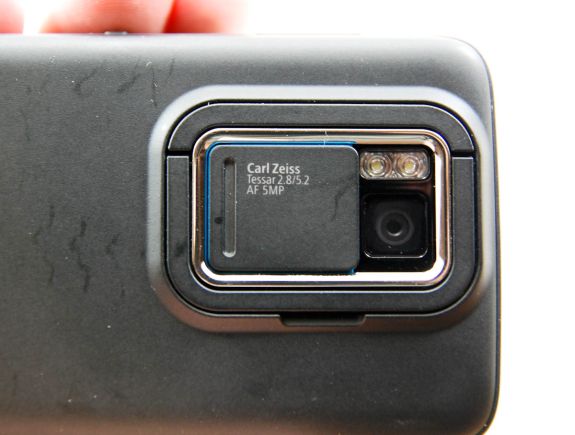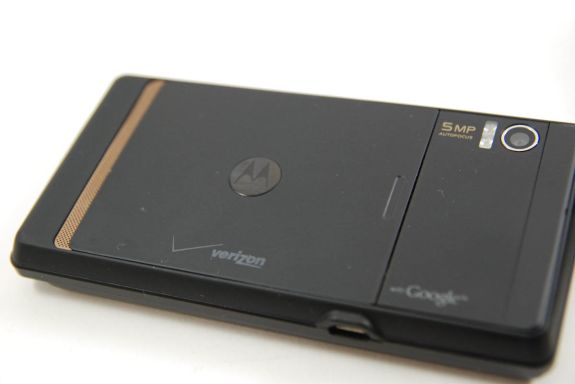Two OMAP 3430 Phones: Nokia N900 and Motorola Droid
by Brian Klug on June 10, 2010 9:29 PM EST- Posted in
- Smartphones
- N900
- Maemo
- Motorola Droid
- Droid
- MeeGo
- Android
- Mobile
N900 Camera
I've already talked briefly about the N900's camera, which is true to form for Nokia devices and pretty impressive. The software implementation that Nokia has put together for the N900 on Maemo is well polished. As mentioned before, sliding the camera cover open while the device is on immediately launches the camera application, or you can get there from the applications window. After launching, there are black bars at each side, the right side of which is used for settings icons. Nokia has included a ton of options here, including optional geotagging, settings for exposure, ISO, and preset shooting modes. You can capture in 3.5 megapixel or 5 megapixel modes, and have ISO 100, 200, 400 or automatic to choose from. In auto mode, it seems like the camera can go all the way to ISO 800 if necessary, but you can't set that manually. True to the rest of Maemo, the camera only works in landscape orientation.
What's really impressive is just how sharp and fluid the N900 camera preview looks while you're shooting. Suffice it to say, only the HTC Incredible really rivals how sharp and detailed the images look in the live preview. Framerate is always solid, and I just left the settings on defaults because I was pleased with the quality. The hardware button itself is two-position. Pushing halfway down triggers autofocus, pressing all the way takes the shot. One of the nice things is that if you jam the shutter button all the way down, it really takes the picture immediately; there's no mandatory AF run before actually capturing. This is potentially really handy if you're trying to capture something quick action and you're already confident it's in focus.
The N900 can capture videos at up to 848x480 at 25 fps in MPEG-4 format with AAC audio. That's an aspect ratio of 16:9 interestingly enough. I was a bit concerned initially about video being shot at 25 fps, but this is becoming more and more the case with 720P class smartphone video. Quality itself is very good as we'll see in a second.
Motorola Droid Camera
The Motorola Droid packs a slightly more standard 5 megapixel camera, also with autofocus and dual LED flash. While it doesn't carry fancy Carl Zeiss branding or advertise what kind of optical lens system drives it, it's likely the same or a very similar OmniVision camera sensor at the core. The Motorola Droid also supports video recording, though at slightly lower 720x480 resolution at slightly higher 30 fps. Video is encoded in H.264 and audio is AAC.
The camera application for the Motorola Droid is also stock Android 2.x. Love it or hate it, the application is essentially uniform across the platform with the exception of HTC's custom camera application like on the HTC Incredible. You've got settings for most of the basic things, but just not as much as you do on the N900 - though both of these have many more settings than iPhone OS which always handles everything with no chance for user override.
The camera can be launched either from the applications menu, or by pressing the dedicated camera button all the way down while the device is on. Motorola talked a fair amount about the copper colored camera button which - I guess - is a feature. Unfortunately, I did encounter a considerable amount of bugginess with the Droid's camera. Launch would periodically take a very long time (well over 8 seconds), in which case you'll probably just give up and move along, and I noticed a very strange quirk where switching from landscape to portrait (eg shutting the keyboard drawer) would result in camera UI elements being drawn in the wrong place. A few times, the frame around the camera preview would just render inside atop the image, which is very frustrating. Killing and relaunching fixes that, though.












68 Comments
View All Comments
akse - Friday, June 11, 2010 - link
I've got my N900 clocked to use 250Mhz idle and 805Mhz stress clocks and it fastens everything by huge amount. 600Mhz is sometimes a bit slow and if you up it a little bit, everything starts to get smoother..The custom kernel is using lower voltages but higher clocks than nokia stock kernel.. which is why 805mhz drains just about the same amount of power than 600mhz with stock kernel.
I just love the fact that you can do that kind of things on this phone..
One guy was asking how to backup sms messages.. well there wasn't any app for it so you could just run a command with sqlite in Xterm to search through the database for all sms's and forward the results with > to a text file :)
Exodite - Friday, June 11, 2010 - link
That's a truly epic article, the in-depth look at both the hard- and software side of things is far and above what I'm used to reading regarding smartphone reviews. Many thanks for that!Looking forward to similar articles in the future.
medi01 - Friday, June 11, 2010 - link
Epic, right, and you don't care that Apple's device is visible where it has advantage but is not shown, where it doesn't. Like on contrast comparison images.Misterious.
Exodite - Friday, June 11, 2010 - link
No, can't say I mind that at all really.Then again I'm not in the market for an iPhone anyway.
Brian Klug - Friday, June 11, 2010 - link
I actually completely spaced on that one - I probably had a 3GS in my pocket when I took those photos.There's no conspiracy - I just thought that the Incredible's AMOLED display would make an interesting comparison with the Motorola Droid's LCD, and the N900's resistive layer would mix things up a bit.
The iPhone screen really shows its age in the numbers from the bench though. It leaks light pretty badly and obviously the lower PPI is... well... bad.
Cheers,
Brian
Rayb - Friday, June 11, 2010 - link
Nokia has been making devices that work without much hoopla for a long time. It is not for everyone but it beats the available iPhone in more useful ways than is possible.Helmore - Friday, June 11, 2010 - link
The Adrena 200 is based on the AMD Z430 GPU. A Z340 does not even exist AFAIK.I know, I'm nitpicking here, but I just thought I had to mention it.
The Adreno 200 runs at a frequency of 133 MHz, giving it a theoretical performance of 133 MPixels/s of fill rate and 22 Million Triangle/s. The Adreno 205 is the same core but running at 200 MHz and is what will be used in the MSM7X30 and QSD8X50A (45 nm version of the current Snapdragon chip with some small tweaks). The SGX530 used in the Droid (OMAP3430) runs at around 100 MHz, which should give it a theoretical fill rate of 250 MPixels/s and a 7 million Triangles/s. On the OMAP3630 the SGX530 will run at 200 MHz AFAIK. That's all theoretical performance, as we all know they're only part of the story. Just take a look at the GTX480 and the Radeon 5870 and you'll know that theoretical performance doesn't get you very far.
fabarati - Friday, June 11, 2010 - link
1) there was a mistake on the N900 hardware page: it's a 3.5 mm jack, not a 1.8 mm. You probably mixed it up with 1/8"2) The N900 can do Video calling over 3G, like most 3G phones in Europe have done since 2003. It works ok, but it's hella expensive, so no one does it more than once or twice.
Brian Klug - Friday, June 11, 2010 - link
Fixed! Thanks!-Brian
wobblysausage - Tuesday, June 15, 2010 - link
Lies! It cannot make a 3g video call.It can make a skype video call (or a google chat video call) over a 3g data connection but this is not the same thing. Not nearly.
I've had my N900 since November and this is the 1 thing I really miss.